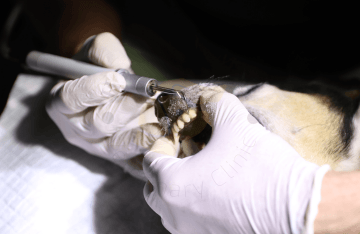Tartal removal
Professional Dental Consultation
The first step before any dental procedure with us is always a professional dental consultation, also known as a dental examination. Without this, we are unable to determine the type, extent, or cost of the necessary dental or dental surgical procedure. We strive to approach our clients transparently to ensure that it is entirely clear what needs to be done and how much it will cost.
The price for a professional dental consultation is 940 CZK.
How Does Dental Hygiene Work?
First, your pet will be sedated (analgosedation) and then a thorough dental examination will be conducted with the owner present to discuss the clinical findings. Based on this examination, an appropriate treatment plan along with a cost estimate will be proposed.
Sometimes, we take X-rays of the teeth before removing tartar, especially in cases such as tooth fractures. X-rays help us determine whether the tooth can be saved or not. More information about X-ray examinations can be found here.
Next, we start removing tartar using hand and ultrasonic scalers to eliminate plaque and tartar above and below the gum line. Tartar below the gum line is the most significant cause of periodontal disease, so it is crucial to remove it thoroughly.
After cleaning and removing the tartar, the entire oral cavity is examined carefully, and all abnormalities are recorded in the dental chart and medical report.
Suspicious teeth are always X-rayed during the treatment to confirm or rule out "hidden" diseases below the gum line. This is where we decide whether the tooth can be saved or needs to be extracted. Occasionally, we may find some pathology during the procedure and may need to call you to approve further steps.
After the tartar removal, the teeth are polished with polishing paste to remove microscopic scratches and slow down the reaccumulation of plaque.
How can I prevent tartar build-up after the procedure?
Plaque forms in as little as six hours after brushing your dog's teeth. That is why mechanical cleaning with a brush and paste is important. More information on plaque and stone prevention can be found here.




















